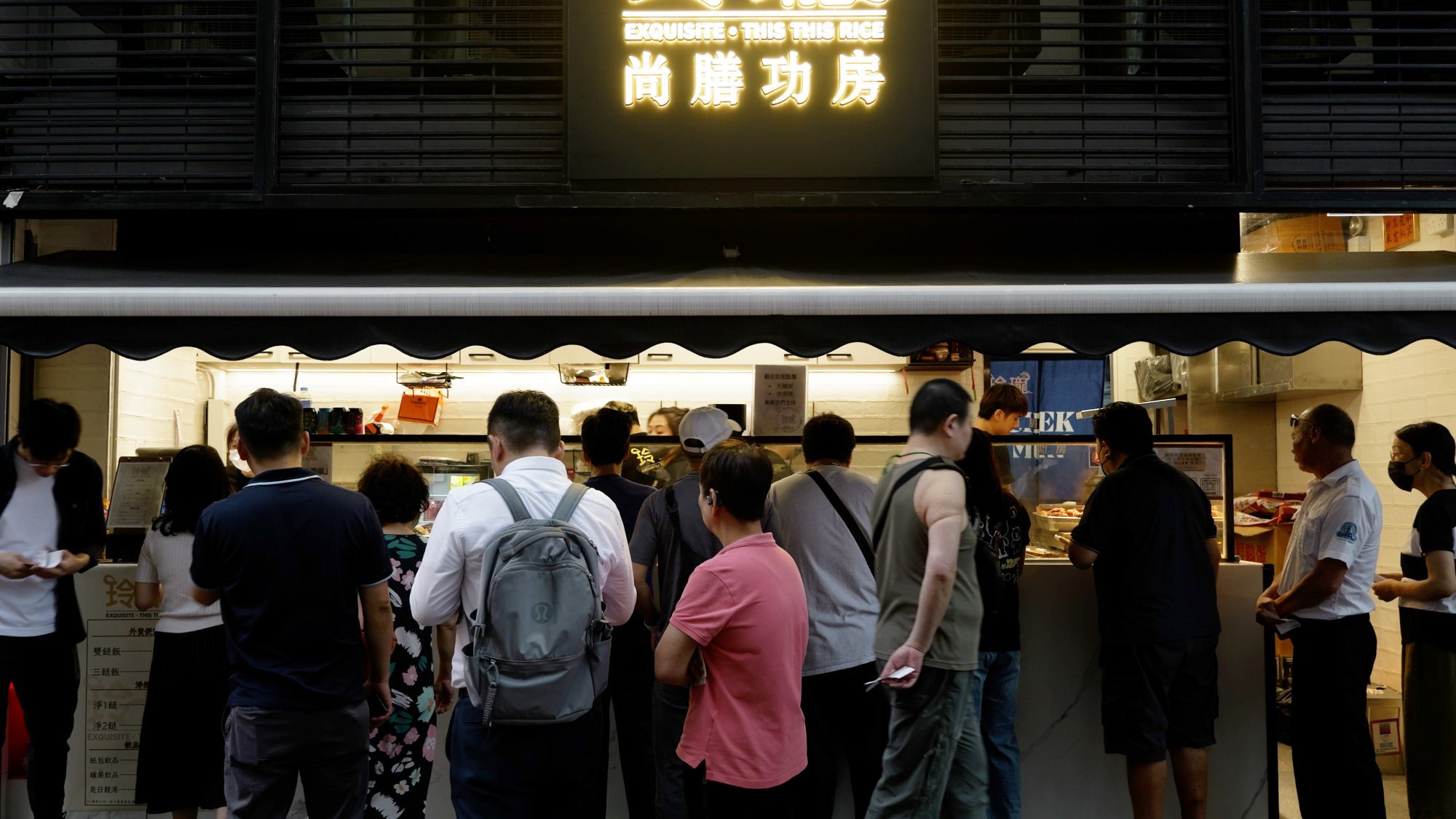The two-dish-rice shops offer cheap lunchboxes and are even opening in some of Hong Kong’s most expensive neighbourhoods at a time when other businesses are closing amid a slow post-pandemic recovery.
Iris Li, an accountant in her 30s, was heading home from Exquisite This This Rice with two lunchboxes and two bowls of soup for her and her husband, for around HK$80.
The shop offers nearly 30 different dishes, with choices such as braised beef brisket and radish, pork trotter with preserved mustard greens, curried potatoes and chicken, and steamed oysters topped with minced garlic.
“I usually choose dishes that I can’t cook at home, such as stir-fried or deep-fried ones. If I were to shop for my own groceries, it would definitely cost me more,” Li said.
Li said she was also in a WhatsApp channel run by the shop that shared its daily offerings.
The number of vendors has grown since then and Facebook boasts a 150,000-strong fan group that shares which stores have the best offerings. A crowdsourced map from the group shows there are now more than 500 two-dish-rice shops across the city.
Before the pandemic, the shops typically operated in lower-income neighbourhoods and had a reputation for selling “poor man’s meals” at HK$20 per order.
Siu Yan-ho, a Baptist University academic specialising in food culture, said the pandemic had normalised eating out of takeaway containers, resulting in such meals becoming widely accepted across all socio-economic classes.
“As vendors became more competitive and the food became more popular, the negative stereotypes surrounding it have also reduced,” he said.
Siu added that pandemic-related restrictions had also altered Hongkongers’ dining habits, with eating convenient meals alone becoming a norm.

Over in the bustling Causeway Bay shopping district on a Monday afternoon, a long queue of customers waited outside Hong Kong Family Food to buy lunchboxes.
The eatery offers two dishes and rice for HK$35, with the option of adding a bowl of Cantonese-style soup for HK$5.
Manager Lo Hung-wan said office workers and students made up the bulk of the shop’s customers.
“With two-dish-rice dishes, there are more options to include vegetables in the meal, compared with the single strand of vegetable that comes with roast meat and rice dishes,” she said.
Service industry worker Dave Nip, 33, was in the fast-moving queue outside the shop.
“Two-dish-rice is considered super value-for-money in Causeway Bay. You cannot get a meal for the same price in a cha chaan teng,” he said, referring to Hong Kong-style cafes.
“Maybe it is just a fresh trend, but its cheap price is the main reason for its rise, as everything has become more expensive in Hong Kong.”
Siu of Baptist University said two-dish-rice shops could afford to keep their prices low since hiring two or three chefs to cook a variety of dishes was more economical than operating a full restaurant with different stations.
While the stores’ initial popularity was due to high unemployment rates and the meals’ low cost, Siu said the opening of more two-dish-rice eateries in recent years was a testament to such food becoming a fixture of Hong Kong’s dining culture.
The concept has also resulted in some novel spin-offs, including higher-end offerings.

Among those offering a different take is JOA, which opened in Central in March and offers rice and two choices from a range of Korean dishes for HK$68.
Customers can choose from Korean favourites such as bulgogi beef, stir-fried glass noodles, fried chicken and braised kimchi with pork belly.
Owners Iggy Hwang and Kim Nam-jin said they adapted the two-dish-rice model to make Korean food more accessible, as dining at such restaurants was expensive.
“I live in Mong Kok and I saw that the two-dish-rice store near my place always has long lines, so I thought why not make a Korean version of it,” Kim said.
Hwang said they kept operating costs low by renting a central kitchen in Tsuen Wan, allowing them to buy ingredients in bulk and supply the cooked food to their takeaway-only store in Central twice a day.
Hwang and Kim said they planned to open another store in Wan Chai in June and were thinking of expanding to Sheung Wan and Mong Kok.
“The economy is bad and the food and beverage industry is facing a difficult situation,” acknowledged Hwang.
“The Hong Kong-style two-dish-rice market is quite saturated, but the Korean version is unique. There can be a lot of variations, for example, Japanese or even Spanish fusion,” he said.
“But the food industry in Hong Kong is big. It is a big pie. So we are optimistic.”
Article From & Read More ( How '2-dish-rice' meals went from Hong Kong workers' staple to culinary classic - South China Morning Post )https://ift.tt/pQFiNal
Entertainment
No comments:
Post a Comment